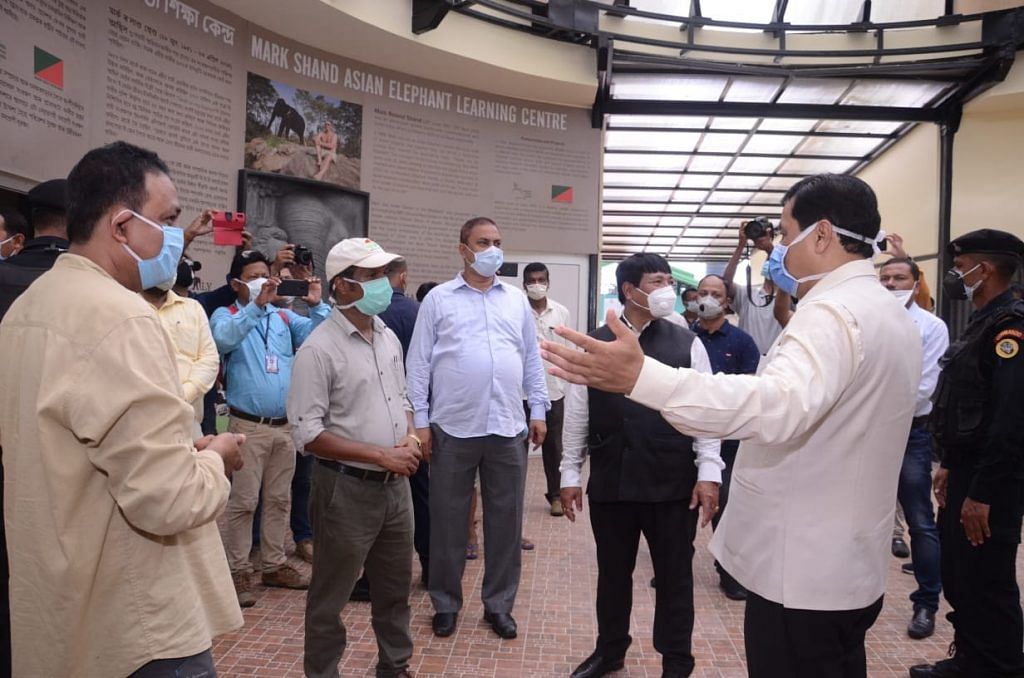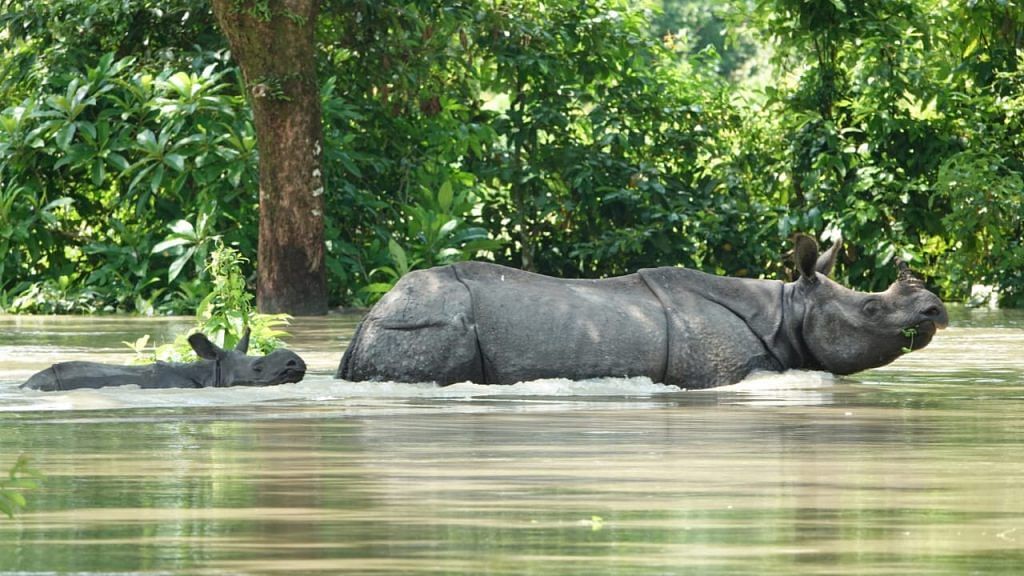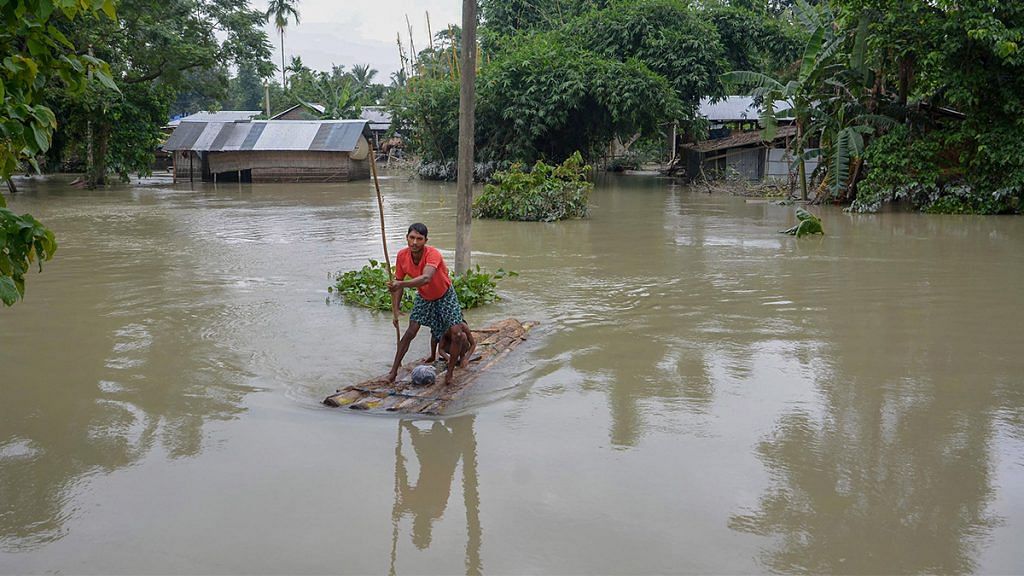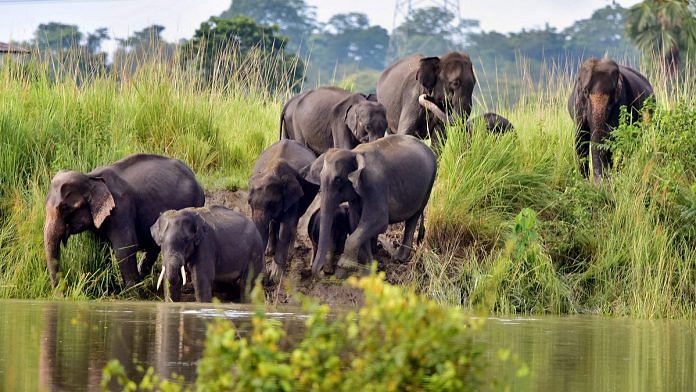New Delhi: As floods continue to ravage the state of Assam, killing 97 people and affecting over 35 lakh others — a major fatality this year has been the Kaziranga National Park and Tiger Reserve.
Nearly 85 per cent of the park’s total area has been submerged by the relentless Brahmaputra river and 96 animals have died as a result, according to the daily flood report released by park authorities Saturday.
While floods are an annual occurrence in the state of Assam, the past two years have proven especially worrisome for the national park. Almost the entire park has submerged for the second year in a row, putting the survival of many endangered species at peril.
According to park director P. Shivkumar, the water levels crossed the ‘danger’ mark this year, which is proving to be a huge problem for several animals, especially young calves.
Assam Chief Minister Sarabanda Sonowal also visited the Kaziranga Park to assess the flood situation Thursday.
“Assessed the situation in #KazirangaNationalPark as vast areas of the world heritage site are currently submerged in flood water. Forest officials, with assistance of civil admin, police and other agencies, providing adequate food and veterinary services to the affected animals,” tweeted Sonowal.

Also read: ‘We are with you’ — Arsenal FC expresses solidarity with Assam battling floods
Several animals at risk in Kaziranga
Officials at the Kaziranga National Park have been carrying out relief measures for the past few weeks and 132 animals have been rescued by them.
This included an endangered female rhino calf that was rescued Tuesday and is currently at the Centre for Wildlife Rehabilitation and Conservation (CWRC). The park is home to 2,200 Indian one-horned rhinoceros, which accounts for approximately two-third of their total world population.
It is also a breeding ground of elephants, wild water buffalo, swamp deer and an increasing population of tigers.
“In upper Assam, the flood situation is a rising trend. As of Monday, it is the sixth highest flood in the history of Kaziranga, the highest one being in 1988. Rescued animals with major injuries and the young ones who are separated from the mother are taken to our rescue centres. Others are released in the highland area,” Shivkumar told ThePrint.
Incidentally, the annual deluge of the Brahmaputra river is actually essential for the park to ensure the animals’ survival, a revitalised grassland, and to ensure the animals move to higher grounds within the park.
The floods also have a regenerative nature that replenish water bodies and maintain its landscape.
However, now, with almost the entire park submerged — for the second year in a row — the animals have nowhere left to go.

Also read: India’s maternal mortality ratio dips to 113 in 2016-18, Assam has highest and Kerala lowest
Over 700 relief camps set up with more than 50,000 occupants
This helplessness spreads to the rest of Assam as well. Even though floods occur yearly in Assam, the loss of lives, livelihood and property remains a stark reality.
In the past two months, the state has witnessed two waves of floods that have affected over 35 lakh people in 3,014 villages across Assam. Almost 1.28 lakh hectares of crop area has been damaged by the floods, according to recent government data.
This year, the situation has also been exacerbated by the Covid-19 pandemic that is raging across the country.
The state has also recorded over 19,000 cases of coronavirus and 48 deaths. With numbers steadily increasing, the yearly floods combined with the monsoon could not have come at a worse time.
“Every year we start afresh. This year it is scarier because of Covid-19. Floods just come and ravage everything we have. My ghumti (small shop) broke, my house is damaged. Now, I can only pray that the flood season gets over soon and my family can go back to rebuilding it all again,” 41-year-old Shamsur Ali from the Barpeta district, who was forced to flee to a relief camp, told ThePrint.
According to a daily bulletin by the State Disaster Management Authority, 711 relief camps have been set up across 28 districts in Assam, with 51,421 people occupying them.
CM Sonowal noted that those residing in these relief camps are being supplied with an uninterrupted supply of food grains, drinking water and medical facilities.
“Besides providing quality materials, [I have] instructed district admin to give special attention [to] maintaining hygiene,” he said.
In the Lower Assam district of Goalpara, one of the worst-affected regions, more than 4 lakh people have been affected and the region has set-up 92 relief camps.
“About 259 villages have been affected, and 4.43 lakh people have been affected. Areas are still under water, exact assessment to understand how many families have been completely displaced, total property damaged, crops damaged can only be done after the water subsidies,” Goalpara District Commissioner Varnali Deka told ThePrint.
“This year the situation is grim and the impact has been more, compared to the last few years. The floods have been heavier, lots of roads have been broken, the embankment also broke,” Deka added.

Also read: Assam reverses 11-day Covid duty for doctors after IMA calls out govt’s ‘whimsical decision’
Why Assam floods every monsoon season
The Brahmaputra river cuts through four countries — India, China, Bhutan and Bangladesh — and divides the state of Assam neatly into two halves. The river system consists of multiple channels and water bodies, and a 5,80,000 sq km basin spread,
However, excessive rains over time have left it reeling with multiple lives displaced or lost, as well as villages, crops and basic infrastructure destroyed.
The naturally dynamic and unstable Brahmaputra river deposits vast amounts of silt — brought from Tibet, where it originates — to Assam’s flood plains surrounded by hills. As a result, this causes erosion and floods.
Furthermore, the situation has been worsened by man-made interventions.
Over the past six decades, Assam governments have spent over Rs 30,000 crore on building embankments across the Brahmaputra river.
According to Partha J. Das, who heads the Water, Climate & Hazard Division of Guwahati-based wildlife NGO Aaranyak, these structures “were proposed only as an interim and ad hoc measure for short-term mitigation”.
Additionally, habitation, deforestation and population growth in catchment areas have compounded the problem further.
“The flood situation in Assam is extremely serious, especially in the Kaziranga National Park (KNP). The frequency of floods in KNP has increased in the last couple of years. The Rajiv Gandhi Orang National Park, Laokhowa Wildlife Sanctuary and Pobitora Wildlife Sanctuary, have also been inundated by the flood wave,” environmentalist Apurba Ballav Goswami told ThePrint.
“There has to be a long term solution for Assam’s flood situation. Animals are getting displaced, even if they move up to the highlands, there is still a problem with food. Timely action needs to be taken, which I feel could be done better,” Goswami added.
Also read: Jobless in villages amid floods — Assam’s returning migrants brace for fight to stay afloat



